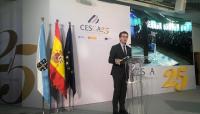 Alberto Núñez Feijóo, President of the Xunta, emphasise in his speech that the Centro Tecnológico de Supercomputación de Galicia (CESGA) has been a bridge between research and enterprises for 25 years, supporting Galician industries and research organisations in their technological challenges. Besides, he pointed out that in the second decade of this century, CESGA will play a key role, being that supercomputing is an essential tool in the digital society and is behind the connected industry, the weather and the sea forecasts, and the genetic sequencing, among other sciences.
Alberto Núñez Feijóo, President of the Xunta, emphasise in his speech that the Centro Tecnológico de Supercomputación de Galicia (CESGA) has been a bridge between research and enterprises for 25 years, supporting Galician industries and research organisations in their technological challenges. Besides, he pointed out that in the second decade of this century, CESGA will play a key role, being that supercomputing is an essential tool in the digital society and is behind the connected industry, the weather and the sea forecasts, and the genetic sequencing, among other sciences.
To this end, Núñez Feijóo announced that, in 2019, the CSIC and the Xunta will start working on the tender of a new supercomputer, acquired by both institutions and starting operation in 2020. Thanks to this investment, CESGA will continue in the elite of the supercomputing centres.
Rosa Ménéndez López, president of CSIC, highlighted that the Xunta and the CSIC made a commitment to the future, which was confirmed in the new ICTS plan and the map that was recently approved. The CESGA is present in the ICTS map as a node of the Spanish Supercomputing Network.
Mauro Fernández Dabouza was appointed last October 3 as the new director of CESGA by the board of trustees of the centre. He has replaced Javier García Tobío, recently retired, who held the position of director for 20 years. During his speech, Fernández Dabouza explained that the CESGA has participated in more than 3000 research publications, 240 doctoral thesis and 1200 scientific contributions in conferences.
During these 25 years since CESGA foundation, the centre has participated in more than 200 R+D projects that involved more than 550 million euros. It offers data processing and storage services to more than 700 users, including companies, research groups or individuals. Currently, CESGA is collaborating with 48 research departments of the three Galician universities, 33 research CSIC departments and practically all Galician technology centres. Last year, the centre participated in 57 projects with 80 companies, which made a total amount of 3 million euros.
The supercomputer FinisTerrae II is the second most powerful in Spain and gives service to RES users since 2016. In total, it has offered more than 26 million hours for research activities in the previous eight RES calls.

